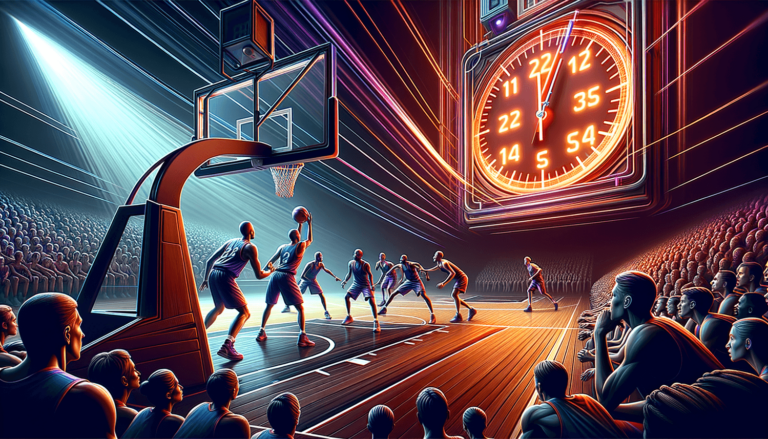
Shot Clock in Basketball: How It Works
Written by: Basketball Universe
Last updated:

Tick-tock goes the clock in the adrenaline-charged world of basketball! If you’ve ever wondered about the inner workings of this fast-paced game and how every second counts, you’re in the right place. Dive into the fascinating universe of basketball’s shot clock, the essential element that keeps both players and fans on the edge of their seats. In this blog post, we’ll delve deep into the origins, structure, rules, and strategies surrounding the shot clock system like never before. So, lace up your high-tops and prepare yourself for a slam dunk of basketball wisdom that will elevate your game – and your knowledge – to new heights!
Shot Clock in Basketball: How It Works
The shot clock in basketball is a timer that ensures continuous game progression and prevents stalling tactics. Set at 24 seconds in FIBA and NBA games and 30 seconds in NCAA games, the shot clock resets after a team takes possession of the ball or when an attempted shot hits the rim. Each offensive team must shoot before the shot clock expires, or they forfeit possession. The shot clock plays a vital role in maintaining the game’s pace, promoting strategic offensive plays, and engaging viewers with high-energy action.
The Origins of the Shot Clock
Before diving into the mechanics of the shot clock, it’s essential to grasp its historical roots in the context of basketball. The shot clock’s origin dates back to 1954 when the then-president of the Syracuse Nationals, Danny Biasone, introduced a revolutionary change to the game of basketball. Biasone’s innovation aimed to speed up the game by eliminating stalling tactics and boosting the game’s thrilling nature. The initial 24-second shot clock proved to be a game-changer, as it helped boost scoring, attract more fans, and transform basketball into the mesmerizing sport we know today.
Understanding the Basketball Rules: Shot Clock Basics
The shot clock’s primary purpose is to promote higher intensity gameplay by setting a time limit for each team to attempt a shot. With two different time limits between leagues, basketball rules dictate a shot clock of 24 seconds in FIBA and NBA games, while the NCAA enforces a 30-second shot clock.
Commencing the Shot Clock Countdown
As the possession of the ball changes, the shot clock timer starts. A few noteworthy instances trigger the shot clock, as outlined below:
Starting a Period or Overtime
At the beginning of each quarter or overtime, the shot clock begins immediately when a player touches the ball after it’s thrown into the court by the referee. It’s important to pay attention to the clock from the very onset of gameplay to ensure your team maximizes its opportunities.
Inbounds After Dead Balls
Following a dead ball situation, such as fouls or out of bounds calls, the shot clock begins once a player touches the inbounds pass. Players typically need to be extra vigilant after these stoppages, ensuring they make efficient use of their limited time.
Missed Shots and Offensive Rebounds
When an unsuccessful shot attempt is followed up by an offensive rebound, the shot clock resets to a shorter time period, rather than the full 24 (or 30 seconds in the NCAA). In the NBA, the clock resets to 14 seconds, promoting faster-paced gameplay and further strategizing on the court.
Managing Shot Clock Violations
Violations occur when a team fails to attempt a shot within the allotted timeframe. Understanding the implications of shot clock violations enhances the overall comprehension of how the shot clock works in basketball.
Defensive Pressure and Shot Clock Considerations
Defensive teams often capitalize on clock pressure, tightening their coverage or employing a full-court press to force violations. This strategy compels the offensive team to make quicker decisions, potentially leading to turnovers or poorly executed plays.
Turnovers and Consequences of Violations
Teams that fail to attempt a shot within the shot clock’s time limit lose possession of the ball. This turnover favors the opposing team, providing them with an opportunity to take control and dictate gameplay.
Exceptional Basketball Rules: Shot Clock Reset
In rare scenarios, the referee can choose to reset the shot clock without a change of possession. This typically occurs when the defensive team intentionally forces the ball out of bounds, an opponent deflects a last-second shot, or a foul is called with a second or two remaining on the clock.
Finding Your Rhythm: Offense and Shot Clock Strategies
The shot clock’s countdown is crucial to the rhythm of basketball. Both players and teams need to adapt their strategies to manage the pressure and optimize their shot opportunities.
Creating Opportunities and Spacing
When working against the ticking clock, offenses must generate open shots and find optimal scoring opportunities. Proper spacing between players, precise passing, and quick decision-making are essential elements in creating an efficient offense under pressure.
Shot Selection: Quality Over Quantity
A vital aspect of maximizing shot opportunities includes choosing high-percentage shots within the time constraints. It’s essential for teams to analyze their strengths and weaknesses while operating against the clock, focusing on shot selections that favor success.
Managing End-of-Game Scenarios
As the game clock dwindles, controlling the shot clock becomes increasingly critical in strategizing end-of-game scenarios. Savvy teams utilize clock management skills to dictate the game’s pace, making precise decisions that influence the final result.
Decoding Shot Clock Trivia and Technicalities
Appreciating the shot clock’s nuances and technicalities brings a whole new level of admiration for basketball as a game of timing and strategy. Below are some intriguing shot clock situations to consider:
Shot Clock Malfunctions and Resets
On rare occasions, the shot clock may malfunction or stop during live play due to technical issues. When noticed by the referees, they may decide to stop the game or allow play to continue, aligning the shot clock with the actual game time elapsed.
Stoppages and Instant Replays
While instant replays are increasingly vital in modern basketball, the referees may consult replay footage to verify shot clock violations, controversial shots, or other clock-related uncertainties.
Last Second Scenarios
As a game draws to a close, last-second situations involving the shot clock can be heart-stopping. Whether it’s an ambitious buzzer-beater or a strategic timeout to conserve precious seconds, these scenarios exemplify the importance of understanding the shot clock’s influence on basketball gameplay.
The shot clock is undeniably a cornerstone of modern basketball, and a comprehensive understanding of its intricacies is vital for appreciating the sport’s exhilarating dynamics. As you continue exploring the world of basketball and its rules, the shot clock’s exciting impact on gameplay will continue to inspire your love for the game.
Gaining the Mental Edge: Shot Clock Awareness
A crucial yet often overlooked aspect of mastering the shot clock in basketball is developing mental preparedness and awareness. Basketball players must train their minds to stay conscious of the ticking clock, gaining an essential psychological advantage that helps them perform effectively under pressure.
Nurturing Anticipation and Timing
Cultivating the ability to anticipate an opponent’s moves and timing within the shot clock constraints can significantly boost a player’s court performance. Good anticipation skills enable players to make better decisions in relation to the shot clock, creating a more efficient offensive game and airtight defense.
Adapting to Pressure Situations
Thriving under the shot clock pressure is a crucial skill that separates good players from great ones. Players who adapt to high-pressure situations can manage the expectations of the ticking clock, executing successful plays even when the seconds are running out.
Improving Communication
Whether it’s relaying the dwindling shot clock time to teammates or ensuring everyone is aware of the next move, effective on-court communication is key to managing the shot clock. Encouraging open lines of communication helps enhance overall team cohesion and synchronize decision-making amidst the challenge of a ticking clock.
Clock Management in Youth and Amateur Basketball
Understanding clock management is essential not only for professional basketball but also for youth and amateur leagues. Implementing the shot clock at these levels teaches players the fundamentals of strategic thinking and time management, fostering valuable life skills.
Integrating the Shot Clock in Youth Leagues
While the NBA, FIBA, and NCAA all utilize shot clock regulations, more and more youth leagues are also adapting to these standards. Introducing the shot clock at the youth level helps players develop time-awareness and sound decision-making abilities that will benefit their overall game in the long run.
Developing Coaches’ Understanding
A crucial aspect of shot clock utilization at any level is ensuring that coaches have a comprehensive understanding of the rules and management strategies. Coaches must be equipped with the knowledge to impart effective clock management techniques to their players, fostering a strong foundation in the sport’s tactical aspects.
Shot Clock Drills for Skill Development
Integrating shot clock-inspired drills into basketball practices can help players develop a strong sense of time management and urgency, preparing them well for competitive match situations. Drills that focus on time constraints foster in players the ability to respond effectively to pressure, optimizing their decision-making skills and overall performance on the court.
By incorporating shot clock dynamics into all levels of basketball and providing players with essential tools to handle time pressures, a true understanding of the art of clock management in the sport can be achieved. As you continue to watch, play, or coach basketball, the fascinating world of ticking clocks and strategic decisions will provide countless thrills and challenges, further deepening your passion for the game.
Frequently Asked Questions
For those looking to learn more about shot clocks in basketball, we’ve put together a handy FAQ section to address some common questions. In this section, you’ll find clear, concise answers to broaden your understanding of this crucial aspect of the game.
Why was the shot clock initially set at 24 seconds?
The 24-second shot clock was chosen based on a calculation by Syracuse Nationals owner Danny Biasone in 1954. He divided the total elapsed seconds of game time by the average number of shots taken within a typical game, determining that 24 seconds would be an appropriate length to keep the game’s pace reasonably fast.
Why does the NCAA use a 30-second shot clock instead of 24 seconds?
The NCAA chose a 30-second shot clock to provide more time for student-athletes in college basketball games to execute plays. This additional time encourages higher-scoring games and allows for more intricate offensive strategies at the collegiate level.
Does the shot clock reset after a steal?
Yes, the shot clock resets to its full duration (24 or 30 seconds) after a steal because possession has changed. The new team on offense will have the full shot clock time to attempt a shot.
How does the shot clock change after an offensive rebound?
In the NBA and FIBA, the shot clock resets to 14 seconds after an offensive rebound has been secured. In NCAA games, the shot clock resets to 20 seconds.
What happens if a player attempts a shot that doesn’t hit the rim and their team recovers the ball?
If the shot doesn’t hit the rim, it’s considered a shot clock violation. The ball is awarded to the opposing team as they gain possession.
Is a turnover the only consequence of a shot clock violation?
Yes, a turnover resulting in a change of possession is the primary consequence of a shot clock violation. The offending team loses both the ball and its chance to score during that particular possession.
How does intentional fouling play into shot clock management?
Intentional fouling can be a strategy to disrupt the opposing team’s shot clock usage. By fouling, the team can potentially reset the shot clock, force the offensive team to take free throws, or disrupt the flow of the game.
How can I improve my basketball clock management skills?
Consistent practice and developing an acute understanding of game and shot clock dynamics are crucial. Participate in high-pressure drills, communicate effectively with teammates, and study game footage to hone your clock management skills.
How do referees handle shot clock malfunctions?
In the case of a malfunction, referees may stop the game to rectify the issue or allow play to continue while adjusting the shot clock to match the actual elapsed time. They may also consult instant replay footage to verify shot clock-related discrepancies.
Is the shot clock used in all levels of competitive basketball?
While the shot clock is a standard feature in professional and collegiate basketball, its usage in amateur and youth leagues may vary. More youth leagues have started implementing shot clock rules to aid in skill development and promote strategic thinking.
Featured Posts
- No pillar pages found.





